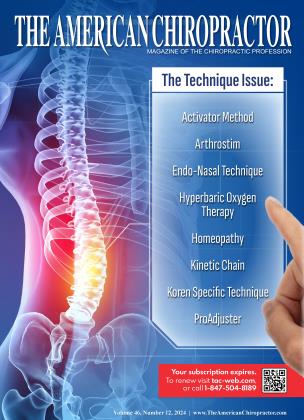By Michael J. Fiscella, DC, DIANM
Our profession has a rich history of pioneering unique health and whole-body integrational concepts that are now more accepted as science continues to evolve. I was introduced to the endonasal technique (ENT) procedure within my first week at Logan Chiropractic College in 1974. ENT was originally called the “ear-nose-throat procedure,” as mentioned in a treatment manual document from Willard Carver, DC, past president of Carver Chiropractic College in Oklahoma City, Oklahoma (1906-1958). Now we refer to it as the endonasal technique.
I had suffered from chronic nasal complaints since my tonsils and adenoids were removed when I was five. After surgery, I continued with medication to manage my residual nasal condition up to my first week at Logan when my assigned student doctor said, “Hey, you have sinus issues. I want to do this technique to you.” He proceeded to inflate a balloon within my nasal cavity, followed by inserting his finger into my mouth to perform a pharyngeal sweep.
My response to the technique was so profound that I decided it was something I knew would help future patients. I had the student doctor instruct me during my treatments until I was proficient enough to start treating some of my fellow students. My formal introduction to this skill was with Russell Gibbons Jr., DC, in 1976 while still a student.
Today, there is a renewed interest in the cranial facial aspect of the ENT procedure, which is just a small part of the entire technique, as well as its overall application in clinical settings. Our profession has a long history with this treatment modality, and chiropractic physicians need to continue to offer nonmedical procedures to manage ear, nose, and throat conditions and cranial distortions. Annually, Logan University’s Office of Continuing Education offers a 12-hour, in-person seminar where doctors can learn the full ENT procedure and how to adapt it to cranial facial adjusting.
Since August 2000, I have taught this technique to hundreds of doctors at Logan University. Around that time, I also met a past jewel in our profession, Lester C. Lahm, DC, who was dean of the postgraduate education department at Western States Chiropractic College. Dr. Lahm had done exhaustive research on the history of the endonasal technique as pioneered by chiropractors in the early 1920s. Another leading chiropractor of this technique was Major Bertrand DeJarnette, DC, author of Technic and Practice of Bloodless Surgery (1939), where he discussed the tonsil and eustachian tube techniques.
As one can see, our ear, nose, and throat (ENT) procedures have evolved with multiple applications and attributes that chiropractic physicians are obligated to maintain and expand within the healing arts. All ENT procedures should be available for us to treat these conditions. My intention is to inform and motivate our great profession to continue those healing applications that we have successfully integrated into our patient management.
We are at a time when many of our principles and procedures are being integrated into the medical model, such as sinuplasty. Many patients will appreciate being able to address their ear, nose, and throat conditions without being put under anesthesia while treated with simple and effective in-office and at-home procedures. Please consider expanding your knowledge and integrating ENT into your practice as another way to serve the needs of your patients.
About the Author
Dr. Michael. J. Fiscella, is a chiropractor with decades of experience, who utilizes various techniques including Receptor Tonus Technique and Endo-Nasal Technique. He offers consultations and continuing education programs. Contact him at Wilmington Clinic LLC: 314-3531477 or visit www.wilminqtonclinic.com
References
1. Lake T. Endonasal, aural and allied techniques: eye, ear, nose, and throat: a manual of manipulative techniques for conditions of anoxia and anoxemia. Health Research; 1976. https://www.mcmillinmedia.com/eamt/files/lake2/l ake2con.html
2. Carver W. Chiropractic analysis of chiropractic principles: as applied to pathology, relatology, symptomology and diagnosis. Vol. I and II. Oklahoma City, OK: Carver Chiropractic Institute; 1922.
 View Full Issue
View Full Issue






